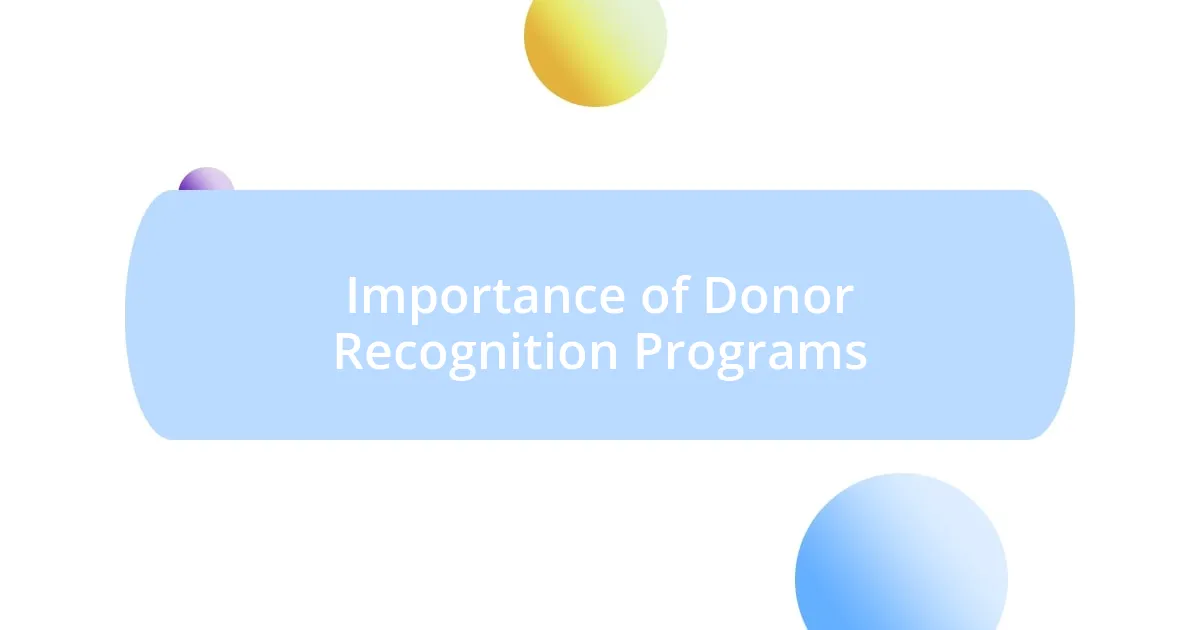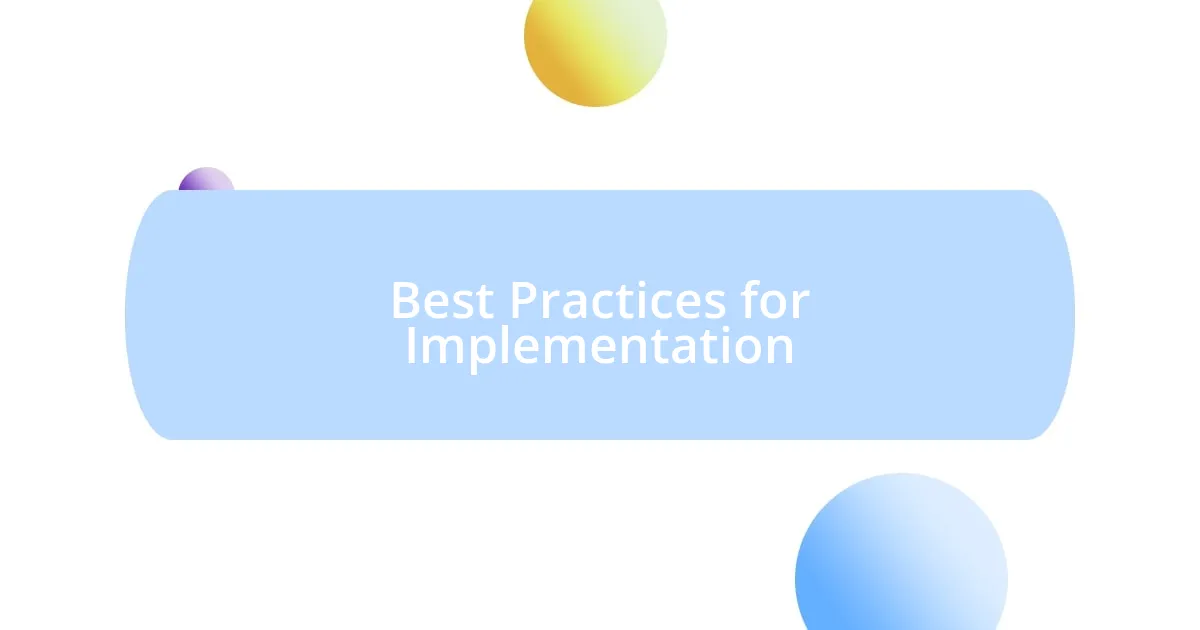Key takeaways:
- Donor recognition fosters appreciation, strengthens emotional connections, and enhances donor loyalty through personalized and timely acknowledgments.
- Key elements of effective programs include personalization, timely communication, variety of recognition methods, impact sharing, and engagement opportunities.
- Successful donor recognition methods encompass public recognition, personal acknowledgments, and exclusive experiences to cultivate deeper connections with donors.
- Future trends are likely to emphasize increased personalization, the use of technology for innovative recognition strategies, and compelling storytelling to maintain donor engagement.

Importance of Donor Recognition Programs
Donor recognition programs hold immense significance in fostering a culture of appreciation and gratitude. I remember attending an event where a nonprofit publicly acknowledged its long-time supporters; the atmosphere was electric with warmth. It struck me how a simple gesture like recognizing contributions not only made donors feel valued but also strengthened their emotional connection to the organization.
When I think about why these programs matter, I can’t help but consider the ripple effect they create. Have you ever felt truly seen and appreciated for your efforts? For donors, knowing their support is recognized inspires them to continue giving. The personal stories shared during recognition events often highlight the real-world impact of donations, making supporters feel like integral parts of a larger mission.
Moreover, effective donor recognition fosters loyalty. I’ve seen organizations that maintain a close relationship with their supporters, ensuring they receive timely and sincere acknowledgments. This connection often translates into higher retention rates of donors, as individuals feel part of a community rather than merely transactions. Isn’t it fascinating how acknowledgment can transform a simple donation into a lasting partnership?

Key Elements of Effective Programs
When I reflect on the key elements of effective donor recognition programs, a few critical components stand out. First and foremost, genuine and personalized acknowledgment is essential. I remember a nonprofit that took the time to send handwritten notes to its contributors. The effort behind those notes created a genuine warmth that no automated email could replicate. It’s about making donors feel like valued individuals, not just names on a list.
Here are some essential elements I believe should be included in any effective donor recognition program:
– Personalization: Tailor messages and acknowledgments based on donor preferences and history.
– Timeliness: Deliver recognitions shortly after receiving support to reinforce appreciation.
– Variety of Recognition: Use multiple channels like social media shout-outs, newsletters, or personalized events to honor contributions.
– Impact Sharing: Regularly communicate the outcomes of donations to show donors the difference they make.
– Engagement Opportunities: Involve donors in events or initiatives, making them feel active participants in the organization’s mission.
Each of these elements plays a vital role in building a lasting relationship with donors. Seeing how these strategies implement emotional connections truly enriches the organizational culture.

Types of Donor Recognition Methods
When discussing donor recognition methods, one can categorize them into various approaches tailored for different types of contributions. For instance, some organizations may choose to acknowledge their donors through public recognition, like naming opportunities on buildings or event signage. I remember attending a gala where the venue had a “donor wall” showcasing names, and it felt invigorating for individuals to see their names in lights. This method not only celebrates donors but also publicly nurtures a sense of community.
Another effective approach involves more personal, direct acknowledgments. Thank-you calls from leadership or handwritten notes can leave a profound impact. I once received a heartfelt call from a nonprofit’s director after I donated. The sincerity in her voice made me feel genuinely appreciated, unlike the generic emails I often receive. I’ve come to realize that these direct interactions help cultivate a deeper connection between the donor and the organization.
Beyond these methods, there are also creative recognition opportunities like personalized experiences or exclusive access to special events. For example, organizations may invite top donors to behind-the-scenes tours or strategy sessions. This level of acknowledgment can significantly enhance a donor’s experience and reinforce their commitment. I had the pleasure of attending a special insight session that transformed my view of how my contributions were shaping the organization’s mission. I left feeling inspired and more connected than ever.
| Recognition Method | Description |
|---|---|
| Public Recognition | Names displayed on walls, event signage, or donor lists to celebrate contributions. |
| Personal Acknowledgments | Direct thank-you calls, handwritten notes, or emails from leadership to express gratitude. |
| Exclusive Experiences | Invitations to special events, behind-the-scenes tours, or strategy sessions for top donors. |

Best Practices for Implementation
To successfully implement donor recognition programs, organizations should prioritize consistency in their approach. I once worked with a group that maintained a regular schedule of thank-you communications. It wasn’t just a one-off gesture; they incorporated monthly updates and acknowledgments into their routine. This consistent outreach made supporters feel continuously appreciated, as if they were part of an ongoing conversation. How often do we think about the impact of regular communication in our relationships? It matters more than we realize.
Another best practice involves actively seeking donor feedback. In my experience, a simple survey asking donors how they prefer to be recognized can open doors to meaningful engagement. One nonprofit I collaborated with introduced feedback forms after events—and the data they gathered led to reshaping the entire recognition strategy. It reminded me of the crucial lesson: our donors have voices that deserve to be heard, and acknowledging their preferences can only strengthen those ties.
Lastly, celebrating even small milestones can yield remarkable results. I recall attending a small, intimate gathering for donors who reached their first giving anniversary. The organization organized a charming ceremony to honor these new supporters, which fostered a deep sense of belonging. Have you considered how impactful it can be to highlight these moments? By marking milestones, organizations create opportunities for donors to feel like integral parts of the journey, driving home the idea that their contributions truly make a difference.

Measuring Program Success
Measuring the success of donor recognition programs requires looking at various metrics. For example, tracking donor retention rates can provide insights into how well your recognition efforts resonate with supporters. When I once analyzed a program’s statistics after implementing more personalized communication, I was amazed to see a noticeable increase in repeat donations—a clear sign that effective recognition can translate into deeper loyalty.
Another essential aspect is seeking feedback from donors themselves. I remember when our team casually asked donors for their thoughts on our recognition efforts. The responses not only highlighted what worked but also revealed areas for improvement. This kind of open dialogue fosters trust and shows you value their opinions, ultimately leading to a more engaged donor base.
Finally, it’s vital to celebrate achievements within the program. I once attended a report-back event where the organization shared success stories related to donor contributions. It struck me how powerful it was to connect the dots between recognition and impact. By showcasing tangible outcomes, organizations reinforce the idea that donors play an essential role, encouraging them to continue their support and involvement. Have you thought about what success looks like for your program? Remember, success isn’t only measured in numbers but also in the meaningful connections you cultivate along the way.

Case Studies of Successful Programs
One standout example of effective donor recognition comes from a nonprofit focused on environmental conservation. They created a “Donor Wall of Heroes” displayed prominently in their headquarters, which listed names of donors at various giving levels. When I visited, I saw the pride on supporters’ faces as they took pictures next to their names. It made me wonder, how often do we miss opportunities to publicly celebrate contributions that matter deeply to both the organization and the giver?
In another case, a local arts organization hosted an annual gala specifically designed to honor their top supporters. They personalized tables with donors’ names and stories, turning a formal event into a celebration of community. I still remember how one donor shared her emotional journey and connection to the arts, and the way the room erupted in applause highlighted the power of personal storytelling. Isn’t it fascinating how one night can transform donors into advocates and friends?
Lastly, I recall a health-focused charity that developed a “Thank-a-thon,” where staff and volunteers made phone calls to express gratitude to donors. The genuine conversations that unfolded led to many donors sharing their personal motivations for giving, creating a deeper relationship between the organization and its supporters. This initiative not only strengthened connections but also inspired new donations, reinforcing my belief that recognition is an opportunity for engagement rather than just acknowledgment. How can we replicate that kind of heartfelt interaction in our own programs?

Future Trends in Donor Recognition
As I look to the future of donor recognition, I can’t help but feel that personalization will become increasingly vital. Through my experience, I’ve seen how tailored messages—not just the generic thank-you notes—can significantly enhance a donor’s feeling of connection. Imagine the impact when organizations start to leverage data analytics to send highly personalized acknowledgments that reflect a donor’s history and preferences. It’s a game-changer, isn’t it?
Technology is also on the rise, paving the way for innovative recognition strategies. Recently, I was part of a virtual event where augmented reality (AR) was used to celebrate donor contributions. It created an immersive experience that left attendees feeling truly appreciated. Wouldn’t it be exciting to think about how digital recognition could evolve further and engage a broader audience? The possibilities are endless.
Moreover, I believe that storytelling will play a crucial role in future donor recognition efforts. When donors hear about the real-world impact of their contributions—told through genuine narratives—they form a deeper emotional bond with the organization. I remember a time when we shared stories from beneficiaries at our donor appreciation events; the atmosphere was electrifying. It makes me wonder: How can organizations continually innovate their storytelling to keep it fresh and engaging for their supporters? Finding that sweet spot might just be the key to sustained donor engagement in the years to come.














